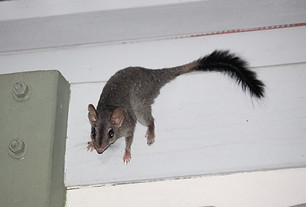RESCUE ADVICE
-
Don't feed or water it!
Please don't attempt to feed a native rodent, bandicoot or dasyurid if you have not received training - why not become a member if this is something that interests you! -
Contain: Contain the animal in a pillowcase with the top tied securely and place this into a secure box or basket with a lid. Provide breathing holes - but otherwise ensure the animal cannot escape.
-
Warm: A water bottle filled with warm water (never boiling) and wrapped in cloth may be placed next to the animal if it is cold or if it is unfurred.
-
Cover the entire box with a large towel to reduce visual and audio stimuli.
-
Secure: Place the animal somewhere warm, dark and quiet to reduce stress until a wildlife rescuer arrives. The animal will be quite terrified, so please don't be tempted to nurse, cuddle, take photos, or allow interactions with kids or pets etc.
-
Poisons: native rodents, bandicoots or dasyurids are nocturnal. Any that are found on the ground in the day must be reported as this is often due to sickness or rat bait poisoning.
-
Cat/dog attack: native rodents, bandicoots or dasyurids that come into contact with cats or dogs must come into care to be treated with antibiotics to stave off infection.
Did you know?
Bandicoots eat both fruit and protein and act like 'little night gardeners' keeping down earthworms, earwigs, cockroaches, crickets, grasshoppers, spiders, adult beetles, beetle larvae and pupae, moths, ants and termites.
Common species in the Hunter Valley
Meet "the others"- these cryptic, shy species are probably in your back yard! Australia is home to dozens of unique native rodent, dasyurid and bandicoot species. Major threats to these animals include habitat destruction and predation by cats and foxes.

Rakali
Hydromys chrysogaster
Also known as "Water Rats" - the Rakali is a semi-aquatic rodent that inhabits waterways and wetlands. Recognized for its sleek fur and webbed feet, this species is an adept swimmer and an integral part of aquatic ecosystems.

Bush Rat
Rattus fuscipes
The Bush Rat is a common sight in a variety of habitats, from woodlands to heathlands in NSW. Its adaptability allows it to thrive in diverse environments.

Spotted-tailed Quoll
Dasyurus maculatus
Known for its striking spotted coat, the Spotted-tailed Quoll is the largest carnivorous marsupial on the mainland. Despite its charismatic appearance, this species faces threats such as habitat loss and competition with introduced predators.

Antechinus spp.
The genus Antechinus includes several species such as the Agile Antechinus and Yellow-footed Antechinus. These small, insect-eating marsupials are known for their frenetic mating behaviour, which unfortunately results in a short lifespan for the males.

Long-nosed Bandicoot
Perameles nasuta
The Long-nosed Bandicoot is a charming and distinctive marsupial that inhabits various ecosystems in NSW. Recognized for its elongated snout, which it uses to forage for insects, small invertebrates, and plant matter, this species plays a crucial role in maintaining a balanced ecosystem.

Northern Brown Bandicoot
Isoodon macrourus
The Northern Brown Bandicoot is a charismatic and resilient marsupial that inhabits various ecosystems north of the Hawkesbury River. It has small, rounded ears, an elongated snout and a speckled, brown-black coat with a pale to white underbelly.

Common Dunnart
Sminthopsis murina
Measuring only a few inches in length, the Common Dunnart is an insectivirous marsupial found across Australia, including parts of New South Wales. Its fur varies in colour; from sandy brown to gray. This species is well-adapted to a diverse range of environments, including woodlands, heathlands, and arid regions.

Brush-tailed Phascogale
Phascogale tapoatafa
The phascogale is a captivating and elusive marsupial that inhabits various ecosystems across Australia, including parts of New South Wales. Known for its distinctive brush-like tail and sleek, arboreal physique, this small marsupial belongs to the Dasyuridae family.
Before you set that mouse trap!

The depths of winter can often be a time when unwelcome house guests arrive, in the form of mice and rats. They often move into houses in an attempt to seek out warmer digs and a source of food. But, it’s also a time when native antechinus can move in, for much the same reason. Also known as a marsupial mouse, this small carnivorous marsupial snacks on insects, reptiles, and sometimes even mice.
The fastest way to tell the difference between an antechinus and a mouse is by looking at their head. An antechinus has a much pointier, long, narrow snout, unlike a mouse, which has a round head and nose. They are also larger than a mouse, with the body length of an antechinus up to 165 mm long, it also has a tail that is approximately the same length as its body. They also have a white ring of fur around their eyes, double-lobed ears, and yellow feet, legs and bellies.
While mice and rats create a musky smell, antechinus have no lingering odour. Antechinus scats are also very different to house mouse scats. They are much larger and cylindrical shaped.
If you're unsure, take some photos and give us a call!

